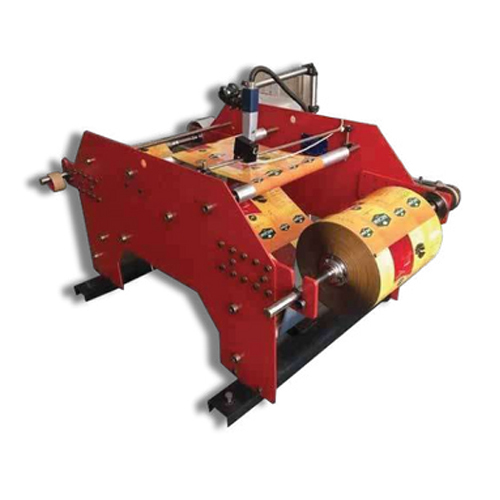
Winder Rewinder Machine
Product Details:
- Usage Industrial
- Power Supply Electricity
- Application Industrial
- Type WINDER REWINDER MACHINE
- Material Iron
- Computerized No
- Automatic Grade Semi-Automatic
- Click to view more
Winder Rewinder Machine Price And Quantity
- 1 Piece
- 180000.00 INR/Piece
Winder Rewinder Machine Product Specifications
- 1 Year
- Red
- No
- Iron
- 380 Volt (v)
- Electricity
- Semi-Automatic
- WINDER REWINDER MACHINE
- Industrial
- Industrial
- Electric
Winder Rewinder Machine Trade Information
- 100 Piece Per Week
- 1 Hours
- Asia, Australia, Central America, North America, South America, Eastern Europe, Western Europe, Middle East, Africa
- All India, South India, Central India, West India, North India, East India, Gujarat, Karnataka, Kerala, Lakshadweep, Mizoram, Meghalaya, Manipur, Andhra Pradesh, Bihar, Chandigarh, Daman and Diu, Goa, Jharkhand, Odisha, Punjab, Assam, Delhi, Dadra and Nagar Haveli, Andaman and Nicobar Islands, Arunachal Pradesh, Chhattisgarh, Haryana, Himachal Pradesh, Jammu and Kashmir, Madhya Pradesh, Maharashtra, Nagaland, Rajasthan, Sikkim, Tamil Nadu, Telangana, Tripura, Pondicherry, Uttar Pradesh, Uttarakhand, West Bengal
Product Description
A Winder Rewinder Machine is an industrial machine primarily used in the processing of materials such as paper, film, foil, textiles, or other flexible materials. The machine is designed to unwind, rewind, and convert materials into specific lengths or rolls, ensuring the material is wound evenly, securely, and with consistent tension.
Key Features of a Winder Rewinder Machine:
-
Unwinding and Rewinding Mechanism:
-
The machine typically has two key components: one for unwinding the raw material (often in large rolls or coils) and another for rewinding the material into smaller, manageable rolls.
-
-
Tension Control:
-
It is equipped with tension control systems to ensure the material is wound or unwound without being damaged or stretched unevenly. This is especially important for sensitive materials like film or paper.
-
-
Adjustable Speed and Roll Diameter:
-
The speed and roll diameter can be adjusted depending on the material being processed and the required end product specifications. This makes the machine versatile for different types of rolls or materials.
-
-
Automatic or Semi-Automatic Operation:
-
Some models feature automatic operation, where the machine adjusts itself for tension, speed, and diameter based on the material type. Semi-automatic models may require some manual adjustments by the operator.
-
-
Edge Control:
-
Some winder rewinder machines include edge control features that ensure the material remains aligned while being wound onto the core or spool, preventing issues like crooked or misaligned rolls.
-
-
Cutting and Splicing:
-
These machines often come with cutting or splicing capabilities, enabling the operator to change rolls or trim material as needed without stopping the machine.
-
-
Coreless Winding Option:
-
Certain models offer coreless winding, where the material is wound without the use of a core, which can be useful for specific applications that require a continuous, coreless product.
-
-
High Precision and Consistency:
-
The machines are designed to provide precise winding, which is crucial for maintaining the uniformity of the product and ensuring that no defects appear in the final wound roll.
-
How It Works:
-
Unwinding Section:
-
The raw material is fed into the unwinding section, where it is pulled from a large reel or spool. The tension is carefully controlled to prevent the material from breaking or being damaged.
-
-
Rewinding Section:
-
After being unwound, the material is guided onto the rewinding section, where it is wound onto smaller rolls or spools. The machine ensures that the material is wound evenly and at the desired tension.
-
-
Tension Control:
-
A crucial feature in both unwinding and rewinding is the tension control mechanism. This ensures that the material is not stretched too much (which could lead to defects) or too little (which could cause under-winding or slippage).
-
-
Cutting and Splicing:
-
If the machine has cutting and splicing functionality, it can cut the material at specific lengths and join new rolls to the material without interruptions in the winding process.
-
-
Edge and Roll Quality Control:
-
The machine may include sensors or guides to control the edges of the material, ensuring uniformity and preventing misalignment.
-
Applications:
-
Paper Industry: Winding and rewinding large rolls of paper for use in printers, newspapers, packaging, etc.
-
Textile Industry: Winding fabric rolls or yarn for further processing or packaging.
-
Film Industry: Rewinding plastic films, stretch films, or metal foils used in various packaging applications.
-
Flexible Packaging: In converting flexible packaging materials into ready-to-use rolls.
-
Printing Industry: Winding printed paper or film for use in packaging, labels, or other printed products.
Types of Winder Rewinder Machines:
-
Single-Winder Rewinder:
-
This machine has a single roll for rewinding and is suitable for smaller or less complex operations.
-
-
Dual-Winder Rewinder:
-
A dual-winder machine can process two rolls simultaneously, making it ideal for larger production runs or for handling materials that need to be split into multiple rolls.
-
-
Slitting Rewinder:
-
Some rewinder machines come with slitting capabilities, which can cut wide rolls of material into narrower ones as they are wound, allowing for multi-width rolls.
-
-
Automatic Rewinder:
-
Fully automated machines that can detect and adjust tension, speed, and roll diameter without requiring operator intervention.
-
Advantages:
-
High Efficiency: Winder rewinder machines automate the winding and unwinding process, increasing production speed and reducing labor costs.
-
Consistency: The ability to maintain consistent tension and uniform rolls improves the quality of the end product.
-
Reduced Waste: By controlling tension and edge alignment, these machines minimize material waste during the winding process.
-
Versatility: The ability to handle various materials and roll sizes makes winder rewinder machines adaptable to different industries and products.

Price:
- 50
- 100
- 200
- 250
- 500
- 1000+




 Send Inquiry
Send Inquiry Send SMS
Send SMS Call Me Free
Call Me Free
